GOSAT Mapping of Global Greenhouse Gas in 2020 and 2021
Abstract
1. Introduction
2. Data and Study Area
2.1. Data Collection
2.2. Study Area
3. Results and Discussion
3.1. The Monitoring of CO2
3.1.1. Monitoring of Global Annual Average CO2 Concentration
3.1.2. Monitoring of Quarterly Average CO2 Concentrations in the World and Major Countries/Regions
3.1.3. Monitoring of Monthly Average CO2 Concentrations in the World and Major Countries/Regions
3.2. Monitoring of CH4
3.2.1. Monitoring of Global Annual Average CH4 Concentrations
3.2.2. Monitoring of Quarterly Average CH4 Concentrations on Global Land and in Major Countries/Regions
3.2.3. Monitoring of Monthly Average CH4 Concentrations on Global Land and in Major Countries/Regions
4. Conclusions
Author Contributions
Funding
Institutional Review Board Statement
Informed Consent Statement
Data Availability Statement
Acknowledgments
Conflicts of Interest
References
- World Meteorological Organization. State of the Global Climate 2021. WMO-No. 1290: 2022. Available online: https://public.wmo.int/en/our-mandate/climate/wmo-statement-state-of-global-climate (accessed on 9 October 2022).
- Boesch, H.; Baker, D.; Connor, B.; Crisp, D.; Miller, C. Global Characterization of CO2 Column Retrievals from Shortwave-Infrared Satellite Observations of the Orbiting Carbon Observatory-2 Mission. Remote Sens. 2011, 3, 270–304. [Google Scholar] [CrossRef]
- Hammerling, D.M.; Michalak, A.M.; Kawa, S.R. Mapping of CO2 at high spatiotemporal resolution using satellite observations: Global distributions from OCO-2. J. Geophys. Res. Earth Surf. 2012, 117, D06306. [Google Scholar] [CrossRef]
- Hammerling, D.M.; Michalak, A.M.; O’Dell, C.; Kawa, S.R. Global CO2 distributions over land from the Greenhouse Gases Observing Satellite (GOSAT). Geophys. Res. Lett. 2012, 39, L08804. [Google Scholar] [CrossRef]
- Yoshida, Y.; Kikuchi, N.; Morino, I.; Uchino, O.; Oshchepkov, S.; Bril, A.; Saeki, T.; Schutgens, N.; Toon, G.C.; Wunch, D.; et al. Improvement of the retrieval algorithm for GOSAT SWIR XCO2 and XCH4 and their validation using TCCON data. Atmos. Meas. Tech. 2015, 6, 1533–1547. [Google Scholar] [CrossRef]
- Wang, X.; Zhang, X.Y.; Zhang, L.Y.; Gao, L.; Tian, L. Interpreting seasonal changes of low-tropospheric CO2 over China based on SCIAMACHY observations during 2003–2011. Atmos. Environ. 2015, 103, 180–187. [Google Scholar]
- Yang, D.; Liu, Y.; Cai, Z.; Deng, J.; Wang, J.; Chen, X. An advanced carbon dioxide retrieval algorithm for satellite measurements and its application to GOSAT observations. Sci. Bull. 2015, 60, 2063–2066. [Google Scholar] [CrossRef][Green Version]
- Yang, D.; Zhang, H.; Liu, Y.; Chen, B.; Cai, Z.; Lü, D. Monitoring carbon dioxide from space: Retrieval algorithm and flux inversion based on GOSAT data and using CarbonTracker-China. Adv. Atmos. Sci. 2017, 34, 965–976. [Google Scholar] [CrossRef]
- Kong, Y.; Chen, B.; Measho, S. Spatio-Temporal Consistency Evaluation of XCO2 Retrievals from GOSAT and OCO-2 Based on TCCON and Model Data for Joint Utilization in Carbon Cycle Research. Atmosphere 2019, 10, 354. [Google Scholar] [CrossRef]
- Seyed, M.M.; Naghmeh, M.D.; Saeed, A.; Oliver, S. Analyzing spatiotemporal patterns in atmospheric carbon dioxide con-centration across Iran from 2003 to 2020. Atmos. Environ. 2022, 14, 100–163. [Google Scholar]
- Butz, A.; Galli, A.; Hasekamp, O.; Landgraf, J.; Tol, P.; Aben, I. TROPOMI aboard Sentinel-5 Precursor: Prospective performance of CH4 retrievals for aerosol and cirrus loaded atmospheres. Remote Sens. Environ. 2012, 120, 267–276. [Google Scholar] [CrossRef]
- Prasad, P.; Rastogi, S.; Singh, R. Study of satellite retrieved CO2 and CH4 concentration over India. Adv. Space Res. 2014, 54, 1933–1940. [Google Scholar] [CrossRef]
- Hakkarainen, J.; Ialongo, I.; Tamminen, J. Direct space-based observations of anthropogenic CO2 emission areas from OCO-2. Geophys. Res. Lett. 2016, 43, 11–400. [Google Scholar] [CrossRef]
- Crowell, S.; Baker, D.; Schuh, A.; Basu, S.; Jacobson, A.R.; Chevallier, F.; Liu, J.; Deng, F.; Feng, L.; McKain, K.; et al. The 2015–2016 carbon cycle as seen from OCO-2 and the global in situ network. Atmos. Chem. Phys. 2019, 19, 9797–9831. [Google Scholar] [CrossRef]
- Buchwitz, M.; Reuter, M.; Schneising, O.; Hewson, W.; Detmers, R.; Boesch, H.; Hasekamp, O.; Aben, I.; Bovensmann, H.; Burrows, J.; et al. Global satellite observations of column-averaged carbon dioxide and methane: The GHG-CCI XCO2 and XCH4 CRDP3 data set. Remote Sens. Environ. 2017, 203, 276–295. [Google Scholar] [CrossRef]
- Uspensky, A.B.; Kukharsky, A.V.; Romanov, S.V.; Rublev, A.N. Monitoring the carbon dioxide mixing ratio in the troposphere and the methane total column over Siberia according to the data of the AIRS and IASI IR sounders. Izv. Atmos. Ocean. Phys. 2011, 47, 1097–1103. [Google Scholar] [CrossRef]
- Parker, R.; Boesch, H.; McNorton, J.; Comyn-Platt, E.; Gloor, M.; Wilson, C.; Chipperfield, M.P.; Hayman, G.D.; Bloom, A.A. Evaluating year-to-year anomalies in tropical wetland methane emissions using satellite CH4 observations. Remote Sens. Environ. 2018, 211, 261–275. [Google Scholar] [CrossRef]
- Nyasulu, M.; Haque, M.; Kumar, K.R.; Banda, N.; Ayugi, B.; Uddin, J. Temporal patterns of remote-sensed tropospheric carbon dioxide and methane over an urban site in Malawi, Southeast Africa: Implications for climate effects. Atmos. Pollut. Res. 2021, 12, 125–135. [Google Scholar] [CrossRef]
- Adiya, S.; Dalantai, S.; Wu, T.; Wu, X.; Yamkhin, J.; Bao, Y.; Sumiya, E.; Yadamsuren, G.; Avirmed, D.; Dorjgotov, B. Spatial and temporal change patterns of near-surface CO2 and CH4 concentrations in different permafrost regions on the Mongolian Plateau from 2010 to 2017. Sci. Total Environ. 2021, 800, 149–433. [Google Scholar] [CrossRef] [PubMed]
- British Petroleum. BP’s Statistical Review of World Energy 2020. 2021.07.08. Available online: https://www.bp.com.cn/content/dam/bp/country-sites/zh_cn/china/home/reports/statistical-review-of-world-energy/2021/BP_Stats_2021.pdf (accessed on 3 March 2022).

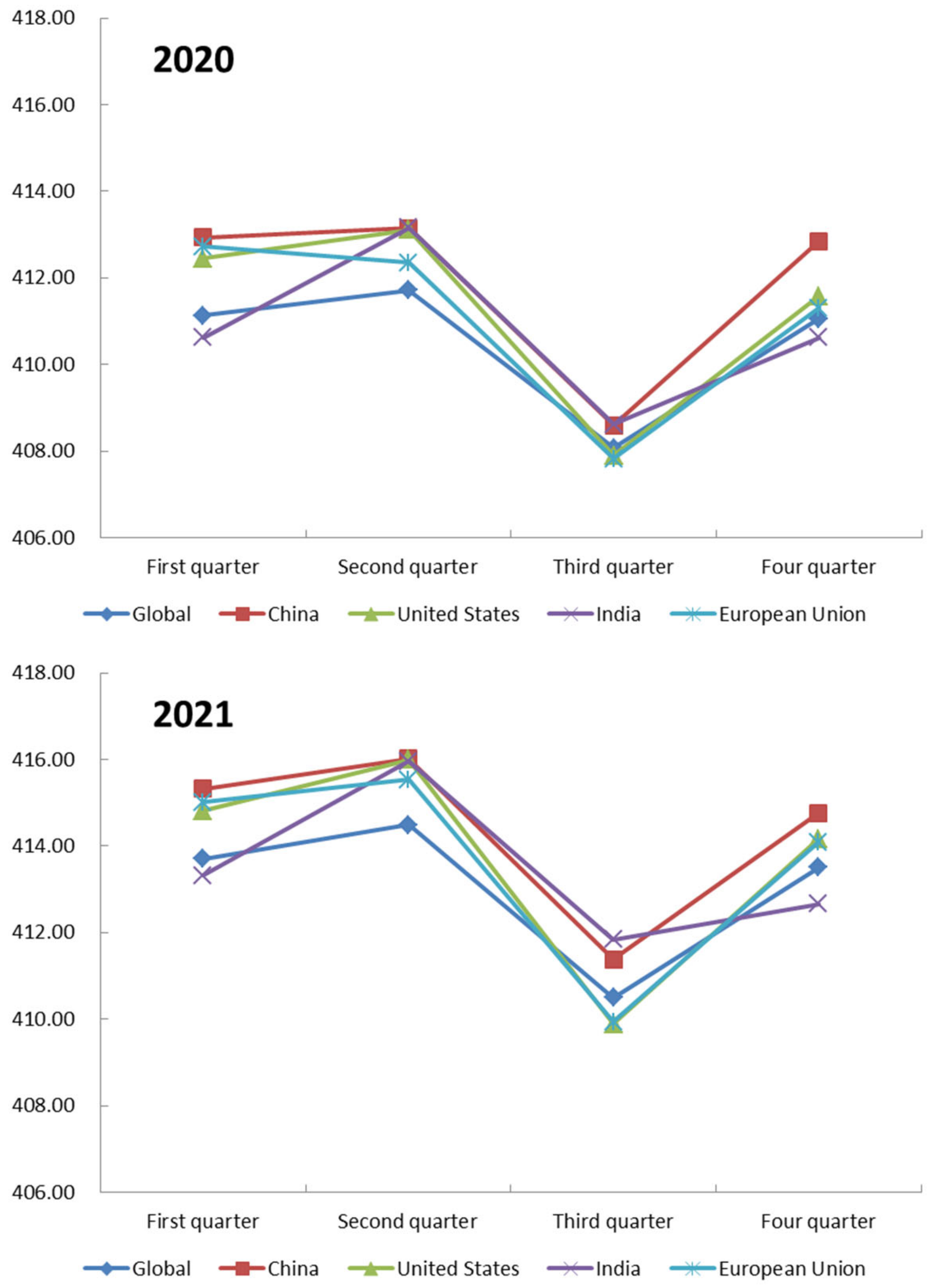
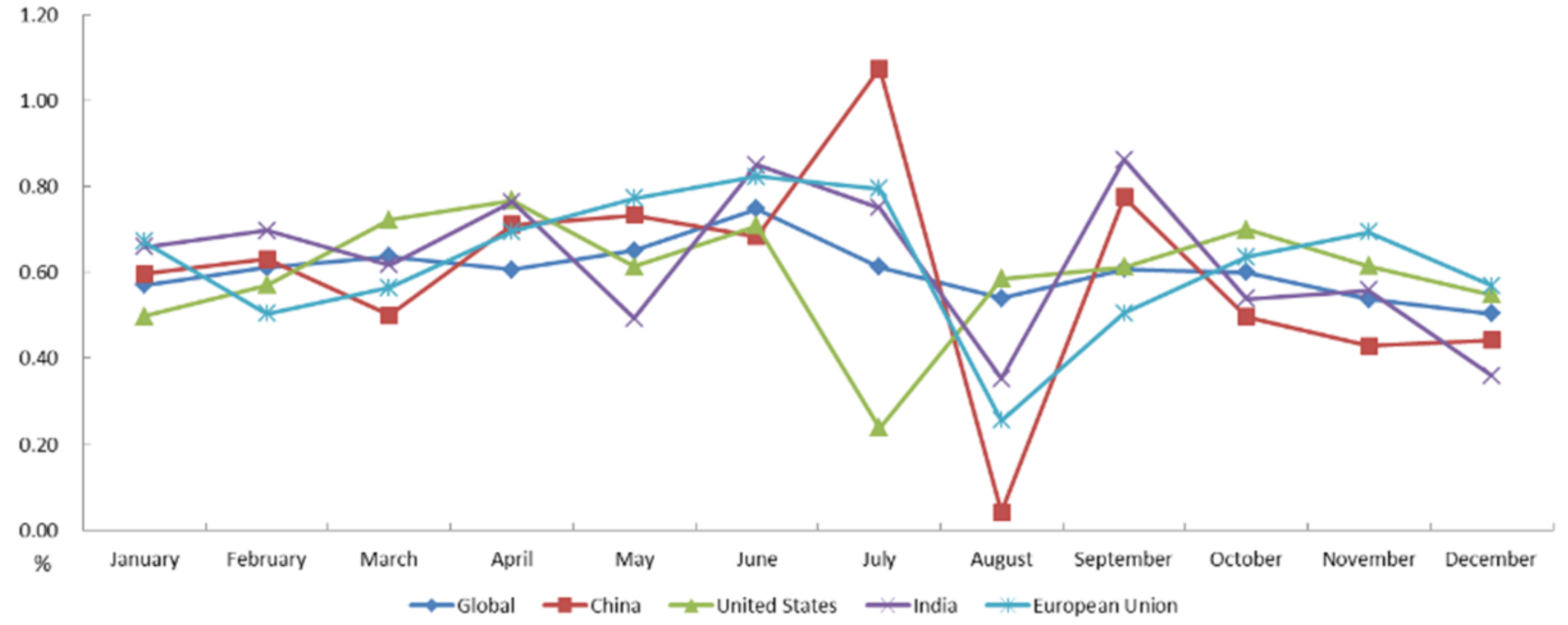
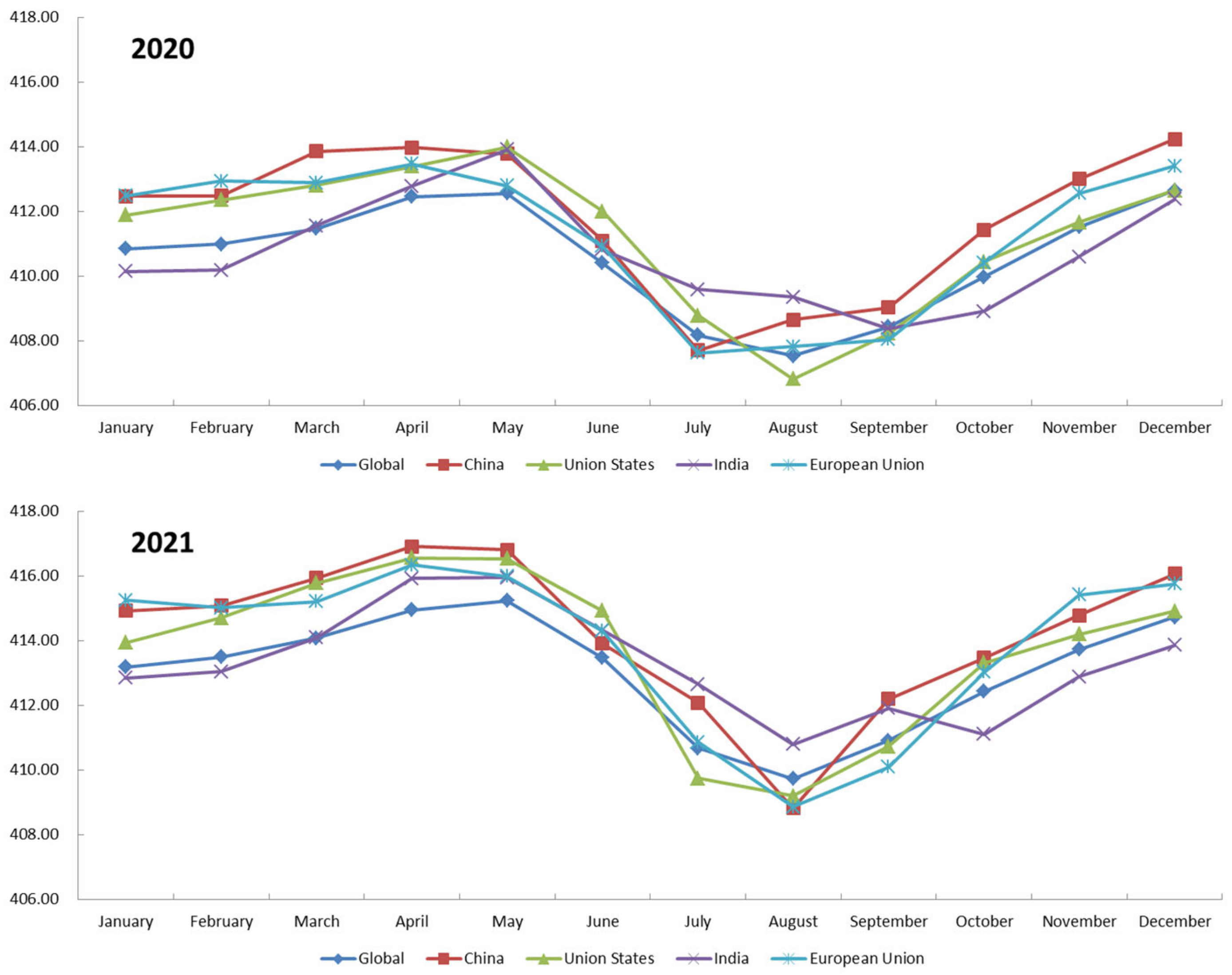
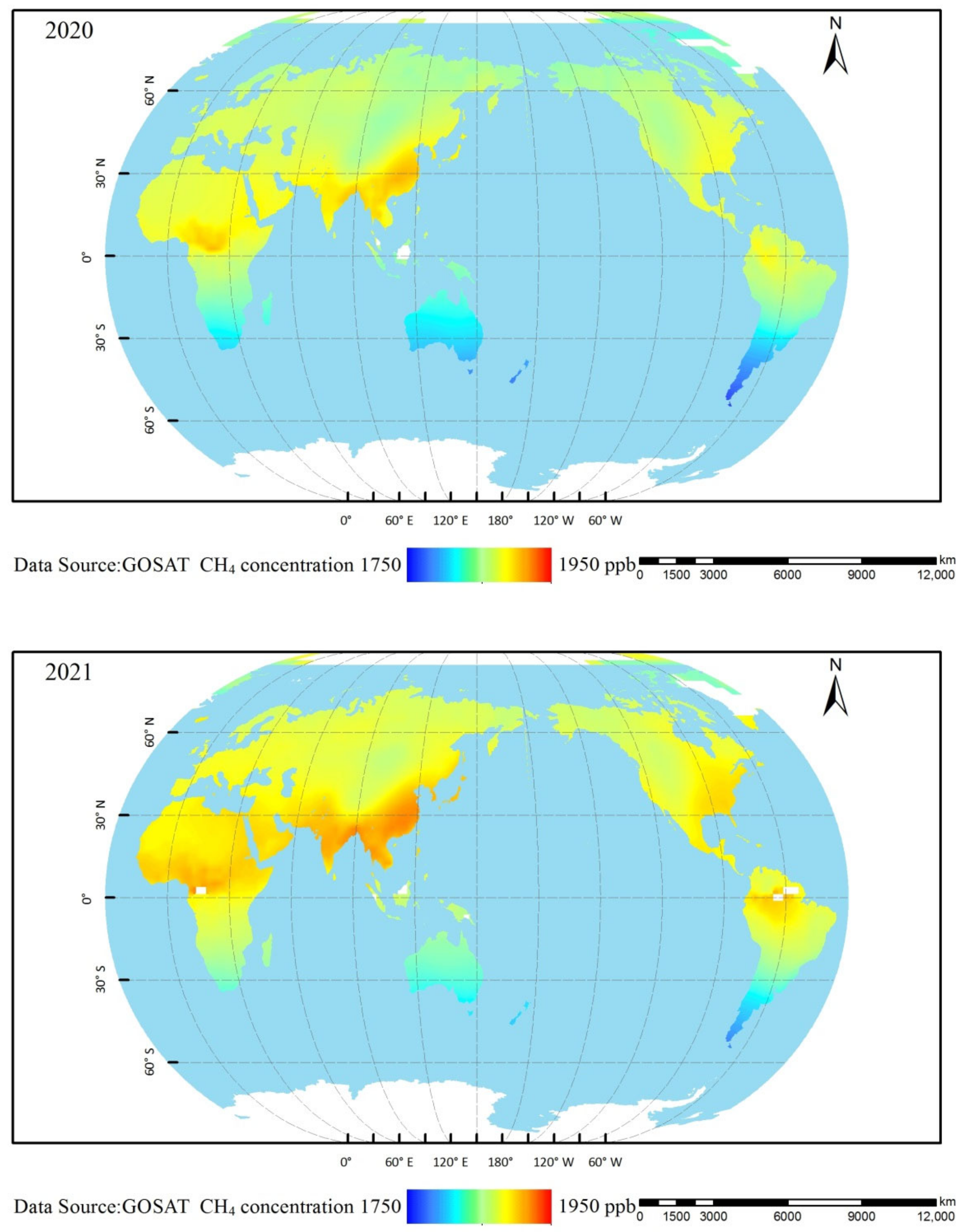
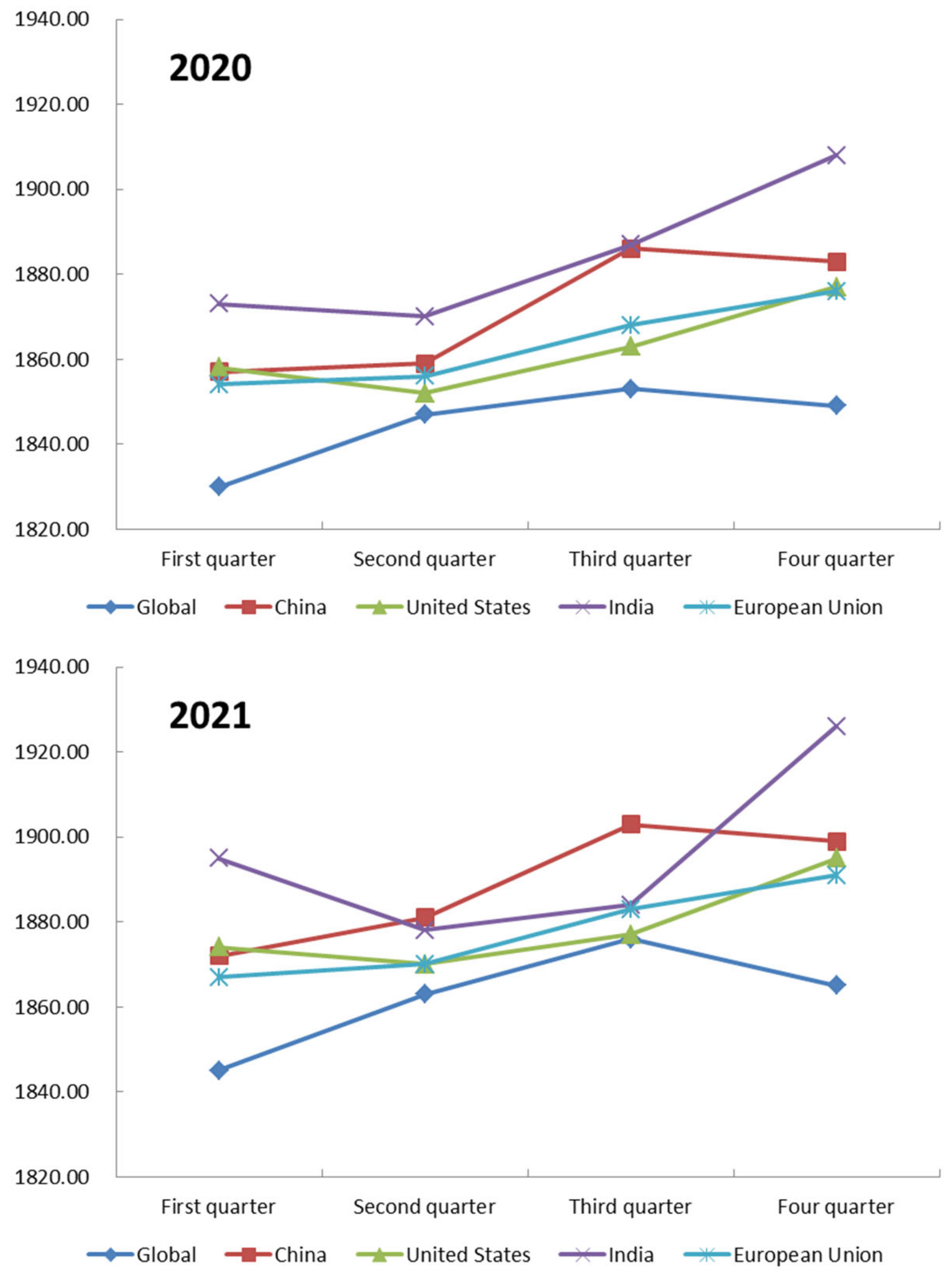
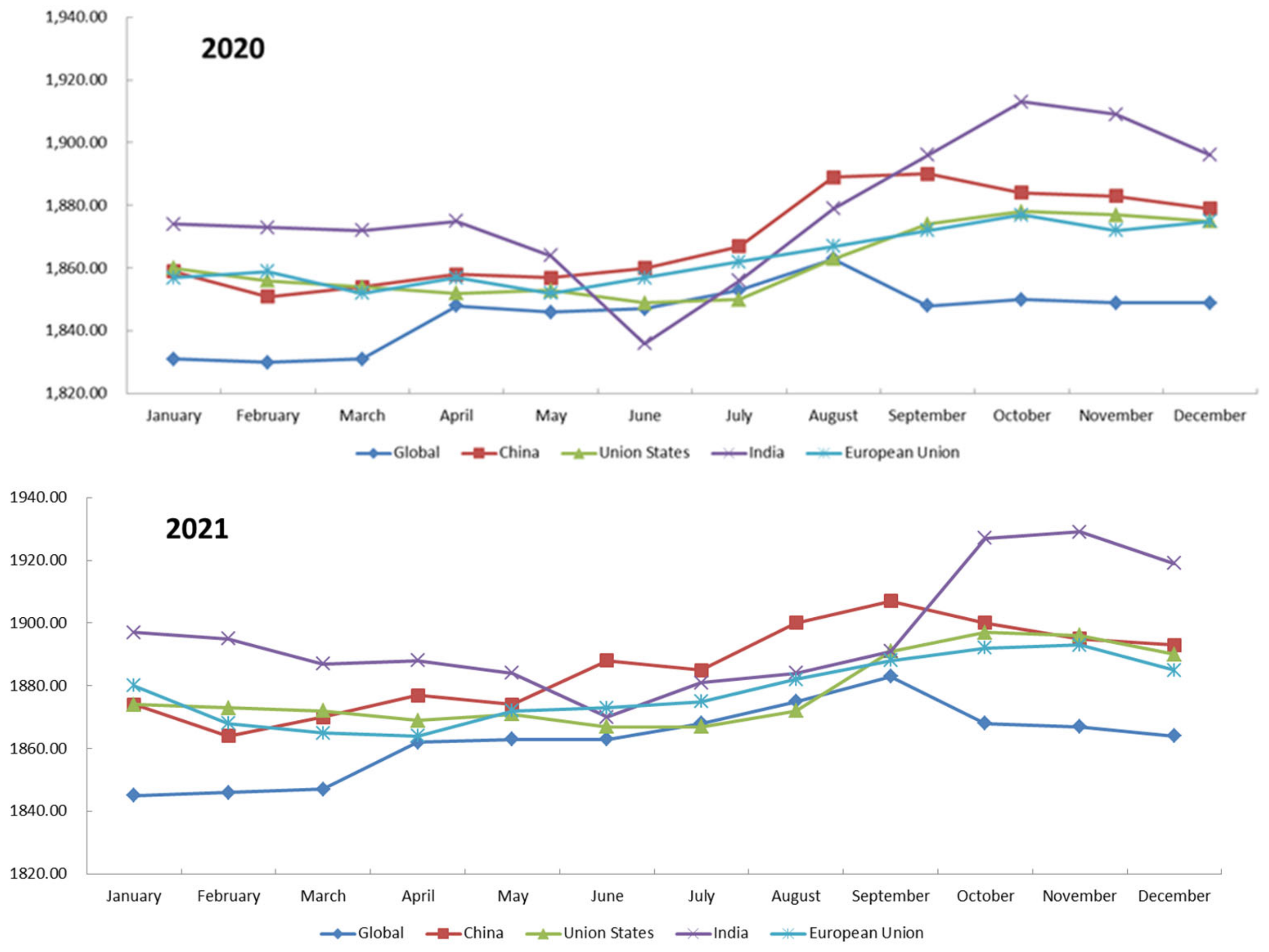
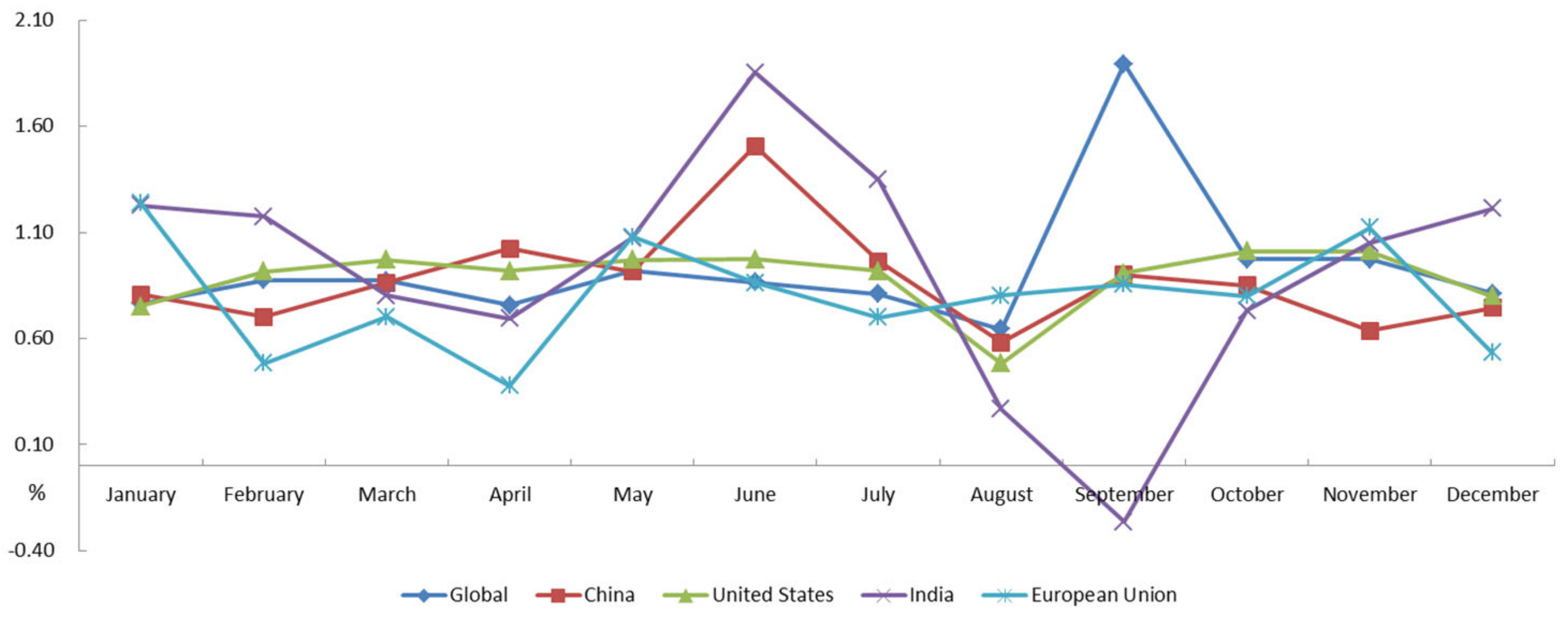
| Major Regions | CO2 | Variation 1 (ppm) | Variation Rate 2 (%) | |
|---|---|---|---|---|
| 2020 | 2021 3 | |||
| China | 411.91 | 414.42 | 2.51 | 0.61 |
| India | 411.13 | 413.53 | 2.41 | 0.59 |
| EU 4 | 410.77 | 413.48 | 2.71 | 0.66 |
| USA | 410.84 | 413.41 | 2.52 | 0.63 |
| Global Land | 410.13 | 412.74 | 2.62 | 0.64 |
| Major Regions | CH4 | Variation 1 (ppb) | Variation Rate 2 (%) | |
|---|---|---|---|---|
| 2020 | 2021 3 | |||
| China | 1886.00 | 1904.00 | 18.00 | 0.95 |
| India | 1872.00 | 1888.00 | 16.00 | 0.85 |
| EU 4 | 1862.00 | 1877.00 | 15.00 | 0.80 |
| USA | 1860.00 | 1876.00 | 16.00 | 0.86 |
| Global Land | 1837.00 | 1853.00 | 16.00 | 0.87 |
Publisher’s Note: MDPI stays neutral with regard to jurisdictional claims in published maps and institutional affiliations. |
© 2022 by the authors. Licensee MDPI, Basel, Switzerland. This article is an open access article distributed under the terms and conditions of the Creative Commons Attribution (CC BY) license (https://creativecommons.org/licenses/by/4.0/).
Share and Cite
Zhang, L.; Wang, Z.; Zhou, W.; Yang, X.; Zhao, S.; Li, Q. GOSAT Mapping of Global Greenhouse Gas in 2020 and 2021. Atmosphere 2022, 13, 1814. https://doi.org/10.3390/atmos13111814
Zhang L, Wang Z, Zhou W, Yang X, Zhao S, Li Q. GOSAT Mapping of Global Greenhouse Gas in 2020 and 2021. Atmosphere. 2022; 13(11):1814. https://doi.org/10.3390/atmos13111814
Chicago/Turabian StyleZhang, Lianhua, Zhongting Wang, Wei Zhou, Xiaoyu Yang, Shaohua Zhao, and Qing Li. 2022. "GOSAT Mapping of Global Greenhouse Gas in 2020 and 2021" Atmosphere 13, no. 11: 1814. https://doi.org/10.3390/atmos13111814
APA StyleZhang, L., Wang, Z., Zhou, W., Yang, X., Zhao, S., & Li, Q. (2022). GOSAT Mapping of Global Greenhouse Gas in 2020 and 2021. Atmosphere, 13(11), 1814. https://doi.org/10.3390/atmos13111814








